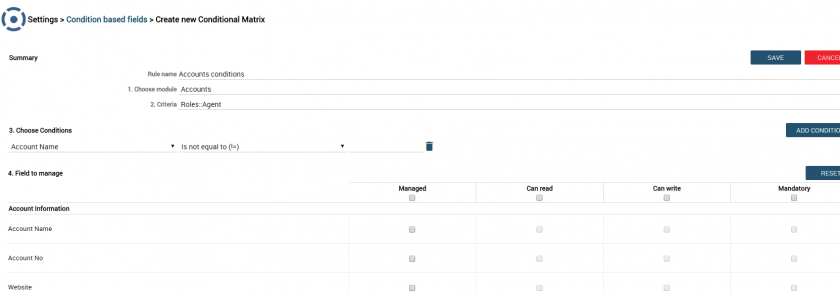17.4 Conditionals
Conditionals allow you to define special permissions to access one or more fields of the same module when a condition defined within it occurs, with the same logic as advanced filters.
When a condition occurs:
- one or more fields are rendered hidden;
- one or more fields are rendered read-only;
- one or more fields are rendered visible and editable;
- one or more fields are rendered mandatory;
- a combination of the above points is created.
These rules can be defined for users who belong to a role, a branch of the hierarchy, or a user group.
Examples of use.
a) In your business activity three types of company are classified (Customers, Partners and Competitors) through the Type field present in the registry. You also need to define an additional specification for each type, by preparing the Specify Customer, Specify Partner and Specify Competitor fields.
You can configure Conditionals as follows:
- if the company is Type = Partner, display the Specify Partner field and hide the Specify Customer and Specify Competitor fields (so that users cannot fill them in incorrectly);
- if the company is Type = Competitor, display only the Specify Competitor field;
- if the company is Type = Customer, display only the Specify Customer field.
b) You have prepared two blocks of information in the registry, one for commercial management and one for technical management. You want to give traders access to technical information, but you do not want to give them permission to change it. Through Conditionals you can redefine the access permissions on the individual fields of the "Technical Information" block by setting them as visible but not changeable for the commercial role.
Let's look at how to create and configure the rules.
Again, only the administrator user can access Settings > Conditionals.

STEP 1: Configuration of the rules.

Enter the name of the rule as you like:
- select the module on which to apply the rule;
- indicate the role or group for which the rule must be valid (the rule will then be applied to all users belonging to that role or group).
The rule can be applied to:
- a specific role (e.g.: Role: Agent)
- a branch of the hierarchy (e.g.: Role and subordinates: Sales Manager)
- a specific group of users (e.g.: Team Marketing Group)

Then enter the condition(s) that must be checked for the rule to be applied. Remember that you can define the rules only on the chosen module.

It is possible to define multiple conditions (Add Condition): all conditions are linked with AND operator. To activate the rule all conditions must be met.
For checkbox type fields (flag), enter 0 for "no" and 1 for "yes".
STEP 2: To access the field permissions configuration area, press Show. Then define the permissions for each field.

|
Managed |
Means managed by the rule, when it occurs. The fields that you do not have to manage should be left disabled; in conjunction with those to be managed, tick the box and proceed with the others. By enabling only this field, without the subsequent ones, the field will be hidden. |
|
Read |
By enable reading permissions, the field will be visible |
|
Write |
By enable writing permissions, the field will be editable |
|
Mandatory |
Makes the field mandatory (function active only in the event of combined use of Status Manager and Conditionals) |
Configuration examples.
Hide a Field (you set it to be managed but do not enable any of the other available permissions)
Make a field read-only (manage it and enable read-only permission)

Versioning: All settings for Conditionals can be saved, generating a version (e.g. v.1.0). Versions can be exported or imported to ensure a higher level of security during setup.
N.B.: the conditional fields are not managed by the mobile app, so the configurations made are valid only for the web version.
